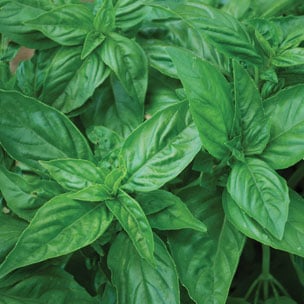
Learning Download: How to Grow Basil
From Seed to Harvest: A beginner’s guide to growing Basil.
Herbs not only enhance food’s taste but can also have many nutritional benefits, with basil being a good example. Basil is often incorporated into Italian dishes and is one of the main ingredients in pesto, but in addition to its delicious taste, basil is an anti-inflammatory, rich in magnesium and has antibacterial characteristics. Herbs grow quickly and are easy to grow in pots on a porch if there is limited garden space. Basil comes in many different options with flavors from sweet to spicy.
To plant:
Basil grows best in warm weather, and basil seeds should be planted after all dangers of frost have passed. Plant seeds 1/4 inch deep and 12 inches apart. Seeds can be started indoors to get a head start on growing the herb. Plant indoors six weeks before the last frost date and place in a sunny windowsill. Plant in moist soil that is well-drained. If planting in a container, use a larger pot to prevent plants from drying out in the summer heat.
To grow:
Basil needs six to eight hours of sun per day. Water the plants freely during dry periods and once flowering begins, pinch off the flower heads to encourage the leaves to continue to grow. Basil does best in soil with a pH of 6 to 7. Since basil likes moisture, place mulch in the pot or around the plants to help retain moisture. Basil should be pruned once the plant has six to eight leaves. After the basil plant is six weeks old, pinch off the center shoot to keep flowering at bay. Basil grows well if planted near tomatoes in the garden.
The biggest threat to a basil plant is root rot from poor drainage, so ensure the planting site has adequate drainage. Also, watch out for pests such as aphids, slugs or Japanese beetles.
To harvest:
Basil leaves can begin to be harvested once the plant is is 6 to 8 inches tall, typically 60 to 90 days after planting the seeds. Picking leaves regularly encourages more growth. Harvest the leaves by pinching them off of the stem, and always harvest from the top of the plant. Basil can be frozen to preserve its flavor, used fresh or dried.
What basil craves:
Since basil is a very fast-growing and leafy plant, it requires fertilizer. Upon planting, add organic nutrients to the soil such as compost, blood meal or cottonseed meal.
Feed with liquid plant food every few weeks to encourage growth, but be sure to not use fertilizers that leave a harmful residue since you will be consuming the leaves.
Where to buy basil seeds:
You can find many kinds of basil seeds ranging from traditional green sweet basil to purple basil at Urban Farmer.
Learning Download: Basil Comparison Chart
Basil Comparison Chart
| Variety | Days | Color | Cut Flower | Organic | Planting | Disease Resistance |
| Ararat | 60 | purple green leaves | yes | container | ||
| Aroma 2 | 70 | green leaves | yes | container, garden, greenhouse | yes | |
| Cinnamon | 64 | green leaves with lavender flowers | yes | container | ||
| Dark Opal | 80 | dark purple leaves | yes | container | ||
| Genovese** | 35 | green leaves | container | |||
| Green Ruffles | 70 | green leaves | container | |||
| Large Leaf Italian** | 74 | light green leaves | container | |||
| Large Leaf** | 70-80 | green leaves | yes | container | ||
| Lemon | 90 | light green leaves | container | |||
| Lettuce Leaf | 65 | green leaves | garden | |||
| Lime | 60 | green leaves | yes | container | ||
| Mrs. Burns | 60 | green leaves with pink flowers | yes | garden | ||
| Pistou** | 60 | green leaves | container | |||
| Red Rubin | 35 | dark red leaves | yes | container | ||
| 75 | light green leaves | container | ||||
| Spicy Bush | 70 | green leaves | container | |||
| Sweet Genovese** | 35 | dark green leaves | container | |||
| Sweet High Oil** | 60-70 | green leaves | yes | container | ||
| Valentino | 80 | light green leaves | garden |
*All American Selection Winner
**Heirloom
***AAS Winner/Heirloom

